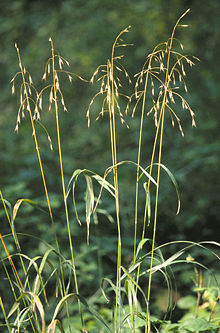Bromus
| Bromus | |
|---|---|
 |
|
| Bromus pubescens | |
| Scientific classification | |
| Kingdom: | Plantae |
| (unranked): | Angiosperms |
| (unranked): | Monocots |
| (unranked): | Commelinids |
| Order: | Poales |
| Family: | Poaceae |
| Subfamily: | Pooideae |
| Supertribe: | Triticodae |
| Tribe: |
Bromeae Dumort. (1824) |
| Genus: |
Bromus Scop. |
| Sections | |
| Synonyms | |
|
|
Bromus is a large genus of grasses, classified in its own tribe Bromeae. They are commonly known as bromes, brome grasses, cheat grasses or chess grasses. Estimates in the scientific literature of the number of species have ranged from 100 to 400, but plant taxonomists currently recognize around 160–170 species.
Bromus is part of the cool-season grass lineage (subfamily Pooideae), which includes about 3300 species. Within Pooideae, Bromus is classified in tribe Bromeae (it is the only genus in the tribe). Bromus is closely related to the wheat-grass lineage (tribe Triticeae) that includes such economically important genera as Triticum (wheat), Hordeum (barley) and Secale (rye).
The generic name Bromus is derived from the Latin bromos, a borrowed word from the Ancient Greek βρομός. βρομός and bromos mean oats, but βρομός seems to have referred specifically to Avena sativa (Hp.Vict.2.43, Dsc.2.94, Polem.Hist.88) and Avena barbata (Thphr.HP8.9.2, Ps.-Dsc.4.137). The generic name Avena is another Latin word for oats or wild oats.
Bromus species occur in many habitats in temperate regions of the world, including Africa, America, Australia and Eurasia. There are considerable morphological differences between some species, while the morphological differences between others (usually those species that are closely related) are subtle and difficult to distinguish. As such, the taxonomy of the genus is complicated.
Bromus is distinguished from other grass genera by a combination of several morphological characteristics, including leaf sheaths that are closed (connate) for most of their length, awns that are usually inserted subapically, and hairy appendages on the ovary. The leaf blades and sheaths, which comprise the leaves can be hairless, sparsely hairy or hairy. The inflorescence is a dense or open panicle, usually drooping or nodding, sometimes spreading (as in Japanese brome, B. japonicus).
...
Wikipedia
